I recently moved a number of outdoor plants inside my house for the winter, and all had been doing well for the last few weeks until this week… when I found a colony of tiny pests on the windowsill, on the rim of the pot, and on the stalk of my banana plant.
I had hosed it down, inspected the leaves, and put it in fresh potting soil to prep for overwintering, but even in the absence of pests to the naked eye, hitchhikers are always a possibility. They lay eggs on the undersides of leaves or hide in the garden soil that was still clinging to the roots.
The aphids seemed to appear overnight, and I needed to get rid of them quickly yet naturally—a high concern since the plants were overwintering in our bedrooms. (Those little white specks are nymphs, or young aphids.)
Read more: Organic Pest Control: 7 Easy Solutions for Getting Rid of Aphids
Luckily, when it comes to fast and easy (and cheap!) pest sprays, DIY gardeners know that it takes just two ingredients to make the best organic insecticide: liquid soap and water.
What is insecticidal soap?
Insecticidal soap is the next step in controlling pests when other natural, non-toxic methods (like hand-picking pests off plants, spraying them off with a sharp blast of water, or introducing beneficial insects to the garden) aren’t working.
Insecticidal soap kills common pests on indoor plants (like potted herbs and other houseplants) and outdoor plants (like vegetable gardens and flower beds) on contact. You can use the same formula indoors or out.
Commercial versions can readily be found in the gardening aisle of your local home improvement store, but this homemade bug spray for your plants is worth making for its sheer simplicity and low cost.
If you have a spray bottle and liquid soap handy, you’re already halfway there!
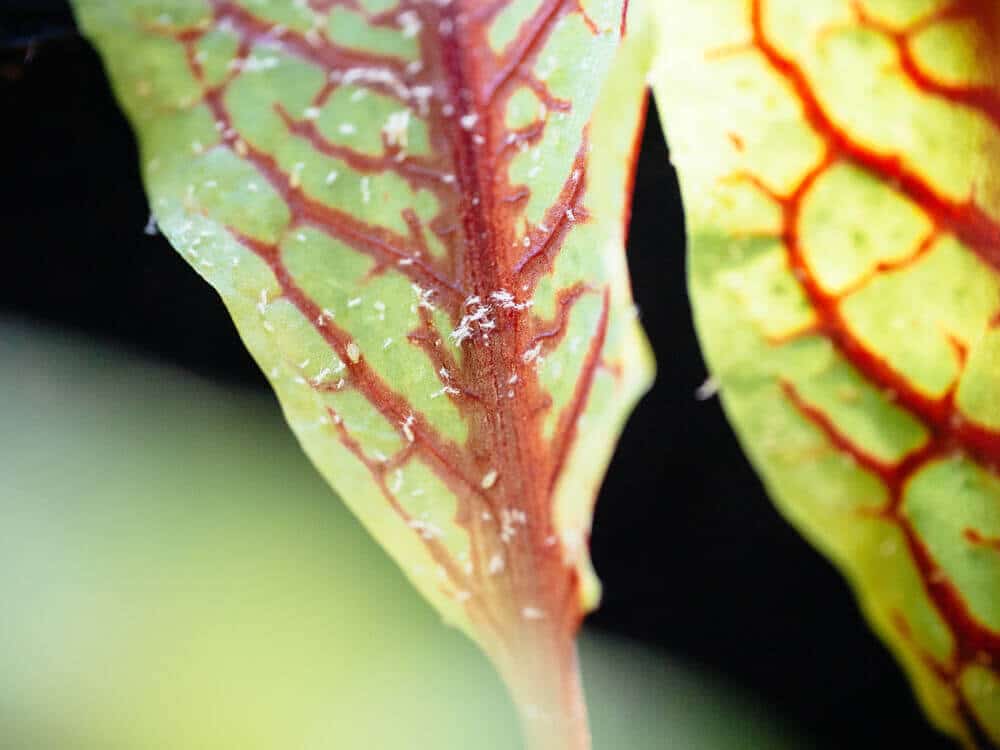
How insecticidal soap works on plant pests
Insecticidal soaps exploit the fatty acids in soap to suffocate small, soft-bodied insects and arthropods such as aphids, mealybugs, thrips, whiteflies, spider mites, leaf hoppers, earwigs, and immature scales (crawlers).
Upon contact, the fatty acids disrupt the permeability and structure of the insects’ cell membranes, dissolving their exoskeletons and fatally dehydrating them.
Contact is the operative word here, as insecticidal soaps only work when sprayed directly on the pests, and are only effective for as long as they remain wet.
Dry soap does nothing.
If you can’t see the pests, you’re not likely to get any results with the spray, homemade or not.
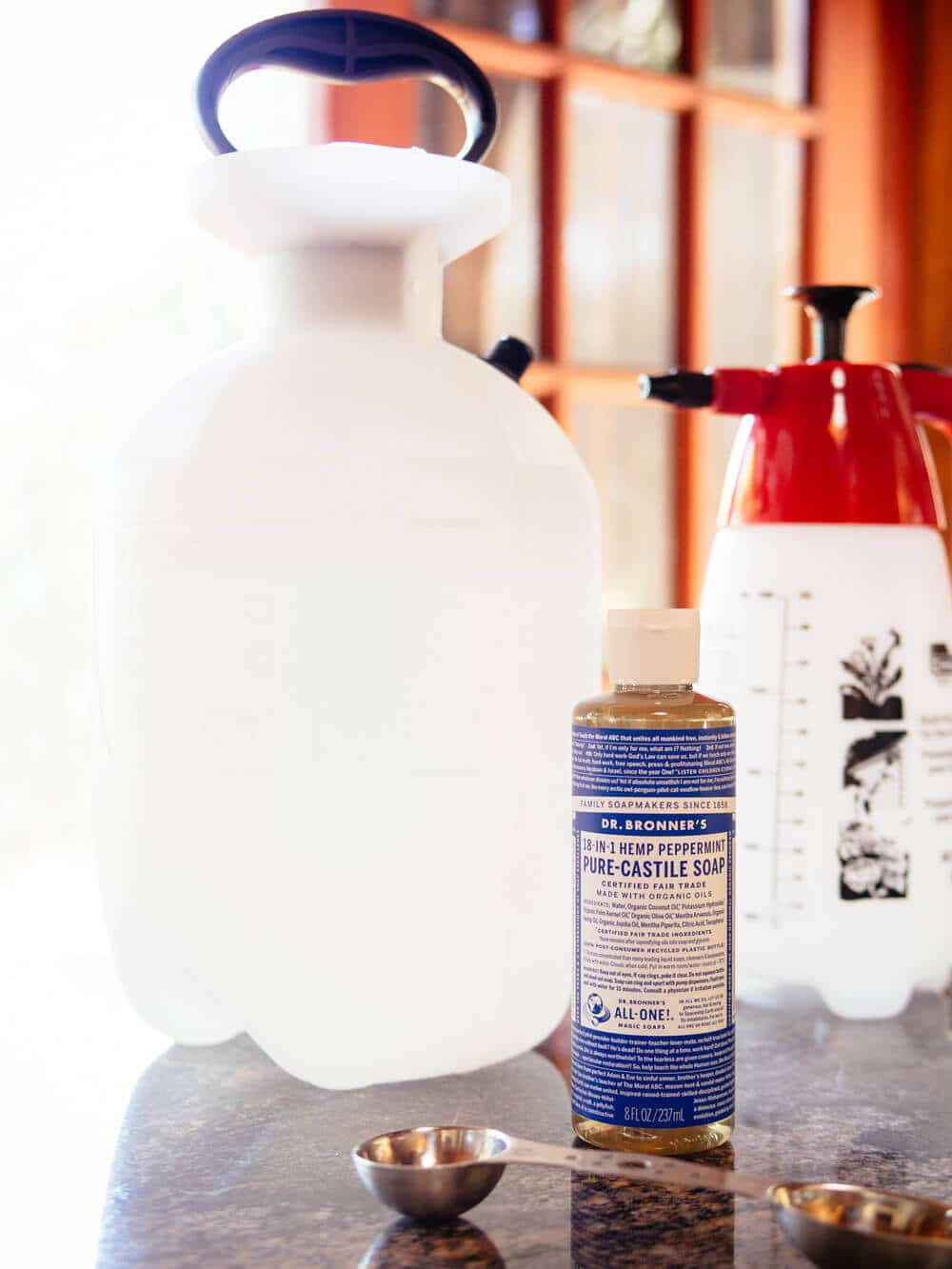
What ingredients are in homemade insecticide?
Essentially, insecticidal soap is a highly refined version of liquid dish soap.
But while many homemade insecticide recipes call for dish soap like Dawn, it’s important that you don’t use Dawn (or similar grease-cutting brands).
Commercial dish soaps like Dawn are more accurately referred to as liquid dish detergents. The detergents, fragrances, and dyes in those kinds of formulations can be harsh on your plants and end up doing more harm than good.
Disclosure: If you shop from my article or make a purchase through one of my links, I may receive commissions on some of the products I recommend.
I personally like the Dr. Bronner’s line of pure-castile liquid soap, which uses fair-trade ingredients and organic oils in its formulations, and is free of additives found in commercial dish soap, hand soap, and laundry detergent.
To put it simply, castile soap is not a detergent like the soap you use to wash dishes or clothes.
Dr. Bronner’s baby unscented castile soap is the most versatile for all applications, but you can try their scented versions for a little extra repelling power in the garden.
Natural scents that repel bugs
- Peppermint is known for deterring aphids, flea beetles, whiteflies, cabbage loopers, and squash bugs
- Lavender repels moths, mosquitoes, fleas, and flies
- Eucalyptus is effective against spider mites, scales, aphids, and earwigs
Castile soap, plus plain old tap water, is all you need for a natural homemade insecticide.
Dr. Bronner’s isn’t the only castile soap you can use, however. I’ve also tried Cove (which I love and use for cleaning the house too) and Quinn’s, and found them just as effective. So use what you can find!
One important note: Hard water can reduce the effectiveness of the soap, so if your water is high in calcium, magnesium, or iron, use distilled or bottled water for the solution.
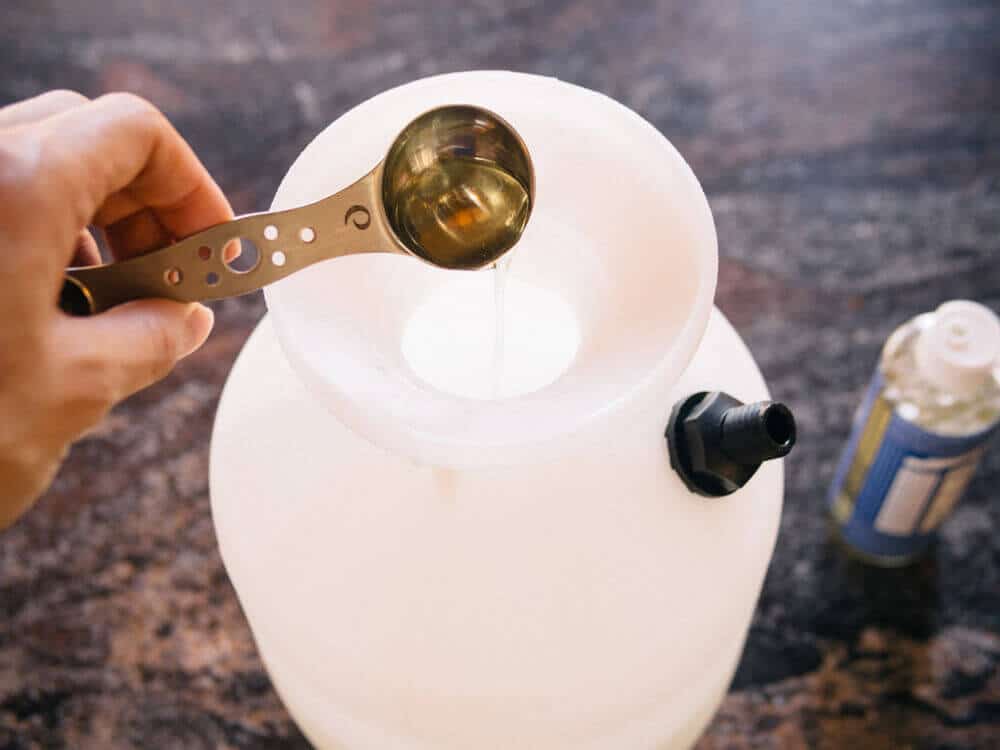
How to make organic insecticide at home
Makes 1 gallon of a 1% soap solution
Ingredients
1 gallon water
2 1/2 tablespoons pure-castile liquid soap
1 tablespoon vegetable oil (optional)
Instructions
Fill a gallon-size spray container (I use this one with great results) with water, then add the soap and oil. Mix or shake the container thoroughly before using.
The oil helps the solution stick around longer after being sprayed. Since the oil can go rancid, I mix up a fresh batch of insecticidal soap every time I need it. If you want to keep some on hand at all times, omit the oil.
To scale the recipe for smaller applications, use 2 teaspoons pure-castile liquid soap for every 1 quart water. (This spray container works well when you have fewer or smaller plants to treat.)
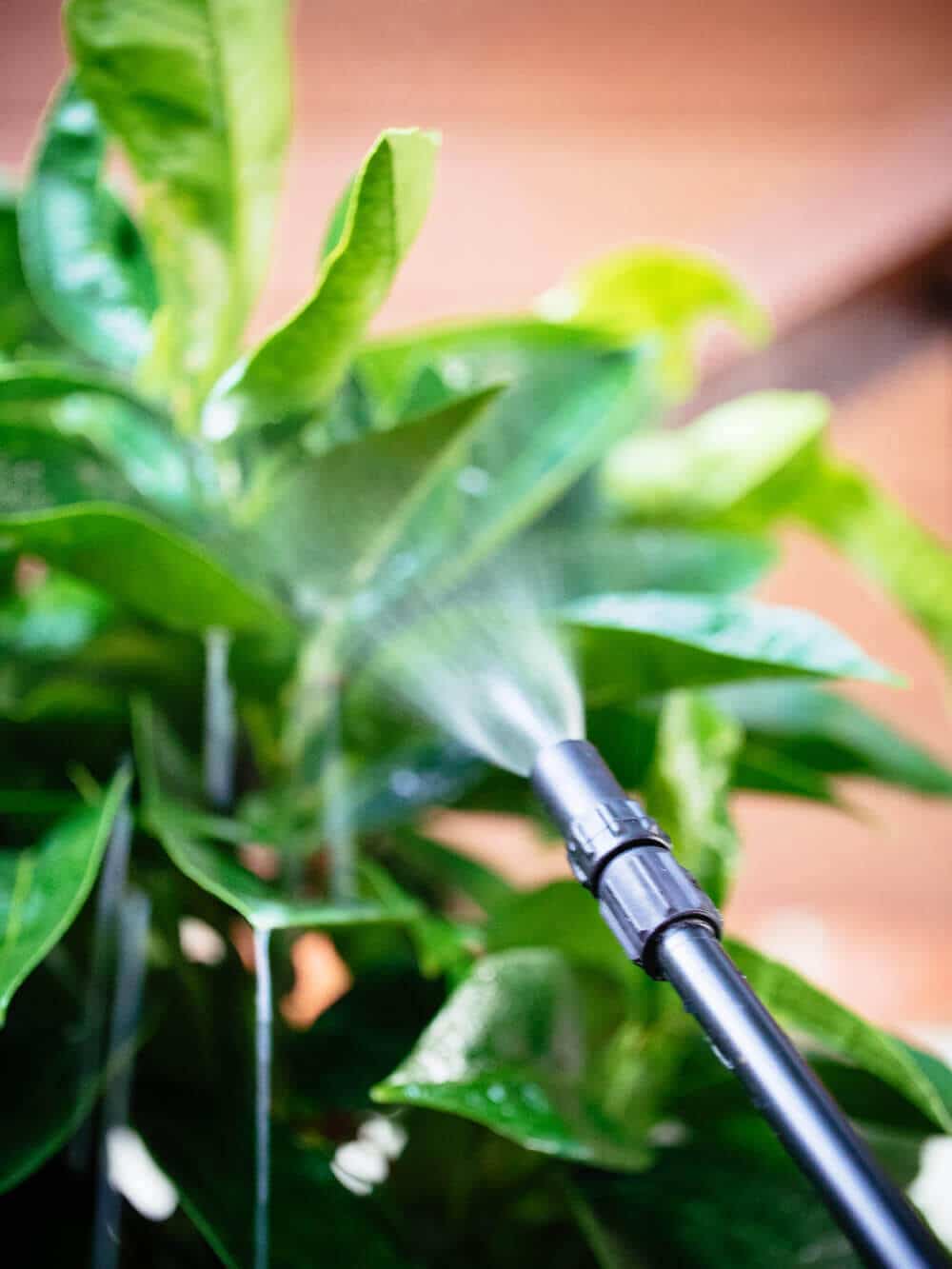
How to apply insecticidal soap to your plants
Dry conditions and hot weather (above 90°F) can increase plant stress and increase your plants’ sensitivity to soap, so avoid spraying on a hot, sunny day and make sure your plants are well watered first.
If you’re trying to treat houseplants, be sure to protect the surroundings from overspray, or move the plants to an area where you can spray freely, like a patio or garage.
Insecticidal soap is best applied in the early morning or early evening, as the cooler temperatures slow evaporation of the soap and favor better pest control.
Pollinator activity tends to be low during these hours, so you have less of a chance of impairing bees, hoverflies, and other beneficial bugs in the garden.
Insecticidal soaps are not systemic insecticides—that is, they don’t absorb into plant tissue. They only work on direct contact with insects, so make sure you cover all plant surfaces where you see pests with a fine spray, including the undersides of the leaves where many pests like to hide.
(Note the emphasis on where you see pests. Simply spraying the whole plant with soapy water won’t work. The soap needs to coat the insects thoroughly—not the leaves—in order to kill them.)
Spray once a week (or for more serious infestations, every 4 days) for 4 weeks until you see improvement. Any more or longer than that, and you risk leaf injury, as the soap will remove all the natural oils and waxes that protect the leaf, and thus remove the plant’s natural defenses against pests and diseases.
Speaking of leaf injury, some plants are more susceptible to soap than others, so I suggest a test spray on a small area first if you aren’t sure how sensitive your plant is.
Wait 24 to 48 hours and check for leaf damage (such as burned tips or yellow or brown spotting) before proceeding with a full application. If you do spot damage, rinse the leaves with clean water to remove any residual soap.
Avoid using insecticidal soap on these types of plants
According to Clemson University’s Cooperative Extension, susceptible plants include hawthorn, sweet peas, cherries, plums, horse chestnut, mountain ash, Japanese maple, bleeding heart, maidenhair fern, crown of thorns, lantana, nasturtiums, gardenias, and Easter lilies, and to some extent azaleas, begonias, fuchsias, geraniums, and impatiens.
Seedlings, new transplants, newly rooted cuttings, and drought-stressed plants are also sensitive to insecticidal soap, so try to incorporate other means of pest control (like row covers or other physical barriers—I’m a fan of this mesh pop-up tent) before resorting to soapy water.
Remember: Less is more when it comes to spraying anything on your plants, even when you’re using natural pest control sprays.
Where to buy DIY insecticidal soap
[show_shopthepost_widget id=”4188320″]
Dr. Bronner’s Pure-Castile Liquid Soap Variety Pack | Dr. Bronner’s Pure-Castile Liquid Soap in Baby Unscented | Dr. Bronner’s Pure-Castile Liquid Soap in Peppermint | Dr. Bronner’s Pure-Castile Liquid Soap in Lavender | Dr. Bronner’s Pure-Castile Liquid Soap in Eucalyptus | Cove Organic Castile Soap in Peppermint | Quinn’s Pure Castile Organic Liquid Soap in Unscented | Spring Chef Magnetic Measuring Spoons | Chapin Lawn and Garden Sprayer | Chapin 48-Ounce Hand Sprayer
Homemade Insecticidal Soap Spray
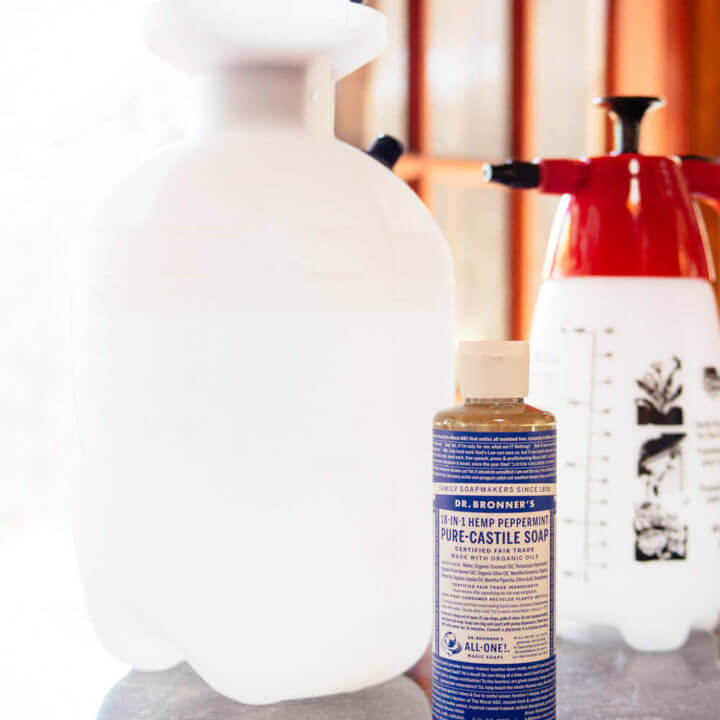
Don't let bugs ruin your plants. A homemade insecticide is your best defense against aphids, and you can DIY a natural pest spray at home with only two ingredients.
Materials
- 1 gallon water
- 2 1/2 tablespoons pure-castile liquid soap
- 1 tablespoon vegetable oil (optional)
Instructions
- Fill a gallon-size spray container with water.
- Add the soap (and oil, if using) and seal the container.
- Shake the container to mix thoroughly.
- Spray the insecticide directly on pests (making sure to get the undersides of leaves where they like to hide). Insecticidal soap is best applied in the early morning or early evening, as the cooler temperatures slow evaporation of the soap and favor better pest control. Avoid spraying on a hot, sunny day and make sure your plants are well watered first.
Notes
The oil helps the solution stick around longer after being sprayed. Since the oil can go rancid, I mix up a fresh batch of this insecticidal soap every time I need it. If you want to keep some on hand at all times, omit the oil.
To scale the recipe for smaller applications, use 2 teaspoons pure-castile liquid soap for every 1 quart water (using a 48-ounce sprayer).
Common questions about homemade insecticide
What’s the difference between insecticide and pesticide?
Though both of these chemical treatments are used to kill living organisms, they each have specific purposes in the garden.
Insecticides are a type of pesticide that only targets insects. Pesticides, on the other hand, are chemicals that may be used to kill fungi, bacteria, other plant diseases, weeds, insects, snails, and slugs. (These last two are actually mollusks, though they’re often lumped together with other insect pests.)
Is it safe to use insecticidal soap on vegetables?
Since homemade insecticidal soap contains only two (non-toxic) ingredients, it’s perfectly safe to use in the vegetable garden to control pests. Just be sure to thoroughly rinse the leaves and fruits of any plant you harvest to remove residual dried soap.
You can also safely treat any affected herbs or fruit shrubs with insecticidal soap.
Can you use insecticidal soap indoors?
Yes, homemade insecticidal soap can be used indoors with a few common-sense precautions.
Before you spray, cover or protect the surrounding area from overspray. Ensure you have good ventilation (or crack a window open nearby) if you’re sensitive to the essential oils in pure castile liquid soap (such as peppermint or eucalyptus). Because the scents are natural and dilute, they tend to dissipate quickly, however.
Can you use other kinds of soap to make insecticidal soap at home?
It’s not recommended to use dish detergent (like Dawn), laundry detergent, or hand soap (even the “natural” versions), since these soaps contain abrasive ingredients that could harm your plants.
For DIY insecticide, organic pure castile liquid soap is the best solution since it’s all natural and highly effective. A little goes a long way!
This post updated from an article that originally appeared on December 18, 2017.
View the Web Story on DIY insecticidal soap for pest control.


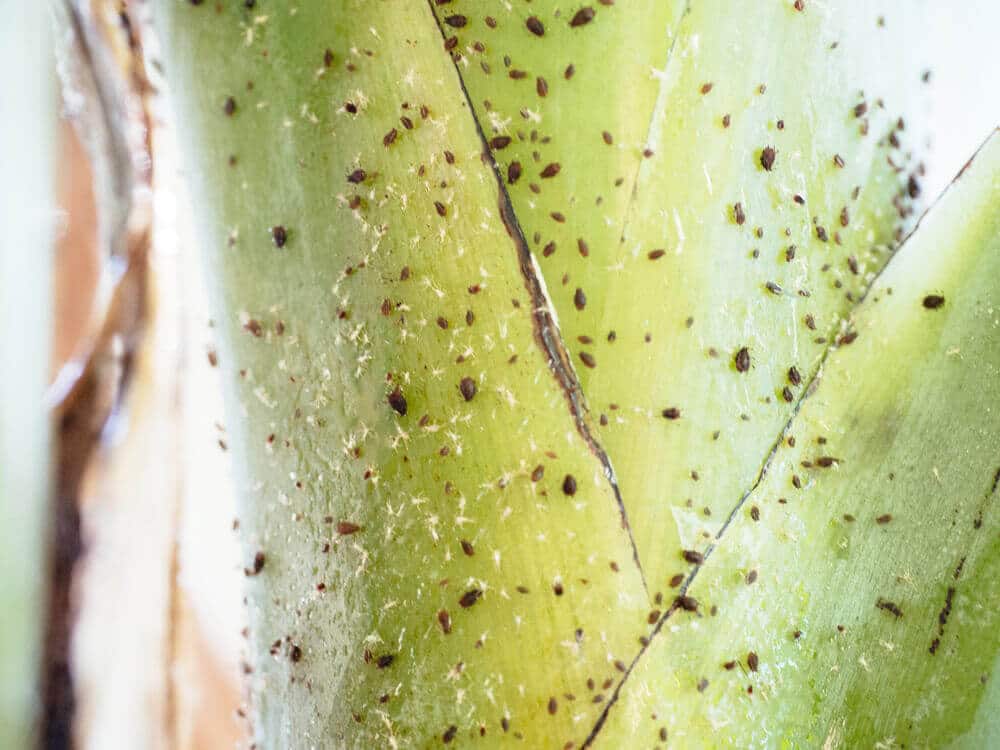













I only have the Castile peppermint bar soap coukd I shave it and let is sit in water until it turned to liquid??
Hi, I just used your home made aphid busting recipe on my American Horse Chestnut tree. I seems to be working already. White flying aphids are killing my tree! I’m going to spray it my tree with water after 24 hrs because that’s what I thot I read. I used the eucalyptus Dr. Bronzer soap because I use it when I shower to repel ticks. I’m just wondering if the spray will hurt or kill the tree itself. And the Aphids or whatever they are starting to spread to other plants. I’m really worried. I love that tree.
It is obvious that this is a paid advertisement for the castile brand she’s tooting!
As a farmer and USDA Inspector, I can honestly tell you. Castile will strip your plants and leave them even more prone to pest and disease.
You’re better off hand picking or lighty spraying your plants.
If this soap is dried after application, it does no good. These insecticides are so small, so cannot identify them. I can only guess what they are after the damage to the leaves have been done. How am I gpoing to spray the live pests? As you said, “they only work on direct contact with insects.”
Hi, I did not see were you said to buy the product, and also will it take care of ants. I have a million and can not seem to get rid of them? Thank you
All the ingredients needed to make this insecticidal soap are linked in the post.
Ants are easy.
1 tbs of any kind of sweetener (cheap syrup, sugar, honey, etc.).
1/2 tsp or a little more of 20 Mule Team Borax or boric acid.
3 tbs warm water.
Stir until all are dissolved.
Set it out in a shallow lid (a water bottle cap is good enough) and let the ants feed all they want. Don’t be tempted to kill them no matter how many show up. The idea is to give them time to take the mixture back to their nest and feed the rest of the population. In less than two weeks they’ll be gone. I’ve seen where they’re gone in one day. If this is done in the spring you probably won’t see any more ants for the rest of the year. Don’t go crazy with this and kill all the ants around your house. You’ll be opening yourself up to termites. Just feed the ones that come into your house.
Thanks we just brought our plants in for the winter in the houses for little flies and this will be great
You are using an unregistered insecticide!!! Is that legal? Did you conduct residue and toxicological studies? If a pesticide company promoted unlicensed insecticide applications, people like you would complain.
Not sure what your concern is. This is a water and castile soap solution made at home. Both ingredients are safe to use.
I came across your article while ‘googling’ about aphids. Each year, my Chinese long bean plants are covered with little black aphids. I normally just spray them off with water, but the plants starts to yellow from too much water. The other day I noticed the aphids are starting to appear. After reading your article, I rushed out and bought Dr. Bonner’s Peppermint Castile Soap and sprayed the plants. The next day, I sprayed the plants with water to wash off the aphids. The following day, I only noticed a few new aphids, so I blasted them with the spray. This method definitely works. Thank you so much for the information.
You’re welcome! I’m so glad it worked for you!
Thank you for this helpful tutorial! After spraying indoor plants do they need to be shielded from light or can they remain in place during treatment? Also, should the leaves be rinsed before next application? What are your thought about adding hydrogen peroxide or isopropyl alcohol to the spray mix? Thank you !
I’m wondering the same. Should I wash the leaves after application?
No, you don’t need to. But houseplants in general like to have a shower so in the normal process of showering your plants, you’d be washing off any residual soap that may build up if you’re using the spray frequently (which, hopefully, you shouldn’t have to). https://gardenbetty.com/spring-cleaning-tip-dont-forget-to-shower-your-houseplants/
Indoor plants do not need to be shielded from light or rinsed before the next application, however certain plants may be more sensitive to the soap than others. There’s a link in the last paragraph that lists potentially sensitive plants (from the Clemson University Coop Extension site) and before using this spray, you should always test a leaf for adverse reactions.
Houseplants in general like to have a shower so in the normal process of showering your plants, you’d be washing off any residual soap that may build up if you’re using the spray frequently (which, hopefully, you shouldn’t have to). https://gardenbetty.com/spring-cleaning-tip-dont-forget-to-shower-your-houseplants/
Also, I do not add anything else besides the pure castile liquid soap.
Hello Linda,
I’m from Cape Town, South Africa.
I came across your website only four days ago and today is the first time reading a section of one of the emails you’ve sent me.
Regarding the “Natural scents that repel bugs” section you indicate:
“Peppermint is known for deterring aphids, flea beetles, whiteflies, cabbage loopers, and squash bugs
Lavender repels moths, mosquitoes, fleas, and flies
Eucalyptus is effective against spider mites, scales, aphids, and earwigs”
Would it be silly to combine all three scents or should it rather be used separately?
Loving your website. Thanks.
Kindest regards and God bless.
Hi Jenny, there’s no harm in combining the scents, but I think they’d be more effective by themselves.
How much peppermint oil should be added to your recipe?
Hi Linda, thanks so much for all your great posts! I make my own soap bars (solid, not liquid) from lard and lye. Can I use that to make insecticidal soap? Much appreciated!
To be honest, I’m not sure how that type of soap will react with plants, since the castile soap I recommend is vegetable oil-based.
Thanks nonetheless! Love your blog!
Hi! Is it safe to spray the soil? Our problem are tiny (aphid?) flies and its bugs and larvaes (the babies?) crawling in the soil 🙂
Yes, it’s safe to spray the soil. But be careful not to saturate it.
Any advice on when to spray your plants? Morning? Night?
The math is off for the gallon recipe vs. small scaled recipe. There are four quarts in a gallon. 5 ml per teaspoon yields 20 ml per gallon for the small scaled recipe, which is 1 & 1/3 tablespoons (15 ml per tablespoon). The gallon recipe is twice the strength of the small recipe at the prescribed 2.5 tablespoons per gallon.
You are absolutely right, thank you for catching that. The gallon recipe is correct, but I’ve fixed the amount in the quart recipe.
2 tsp per quart X 4 quarts per gallon = 8 tsp
3 tsp per Tbsp. so 8tsp/3= 2.6 Tbsp.
the math is correct
You can also add a 1/2 teaspoon cayenne pepper (for its pest properties) or 1/2 teaspoon cinnamon for its anti fungal properties (helps with those awful Fungus Gnats) I have a bottle mixed for each of those add one. I never use tap water though and only use distilled water for all my plant care because I have a few ants with known fluoride sensitivities that causes not just brown tips but my plants were merely existing until i switched from tap water so I don’t even spray their leaves with it. My chlorophytum orchidastrium ‘fireflash’ (orange spider plant) was the plant I learned about fluoride sensitivities on. It was always wilty and puny and from the day I repotted it in tap water free soil and never used it again it has turned into the beautiful plant it should be. I’ve since learned of a few others of mine with that issue. Idk if we have higher levels or what but that’s the only reason I point out that because it can affect plants. Thank you for taking the time to explain how different essential oil scents can be used. I knew I had read thst somewhere before but I couldn’t find the article anywhere and apparently it’s not commonly put into soap articles cause this is first one I came across explaining it. I appreciate it
That’s very interesting about the fluoride sensitivities; I don’t think I’ve heard that before. I do know that chlorine can negatively affect microbial populations in soil, which is why it’s often a good idea to leave your tap water sitting out overnight before you use it to water your plants. (In the past, I’ve also used a chlorine filter on my garden spigot.) This all depends on the quality of your municipal water supply, of course. (We’ve since moved to Central Oregon where neither substance is found in our tap water.)
Thanks this helps a lot
You’re welcome! Good luck!
Hello and thank you for this very informative article with instructions and recipe. I am wondering if peppermint eucalyptus and lavender essentials oils would be okay to add to this insecticidal soap?
Yes, they are all very aromatic oils that repel pests.
Thank you for the great instructions! I was looking for a way to diy insecticidal soap, because who has money or space to buy MORE things for the garden. This is also very detailed, has helpful photos, and I like that you explained why you did things unlike any other tutorial I could find. I’m sharing a link to this in my post on rose care because I know great information like this is what my readers need, because it’s exactly what I needed!
Thank you for sharing it, I’m glad you found this information helpful!
Thanks for the instructions and the thorough explanation of how this insecticidal soap works on the aphids. I too brought in some plants for the winter and recently noticed a severe aphid infestation. I whipped up a batch of this soap and applied it just now so I’m hoping for success. In case anyone wants to make a smaller batch, I used a generic trigger-style spray bottle and converted to 20 fl. oz. water with 1.25 tsp. soap.
Thanks so much for this. I always thought Dawn was the liquid soap of choice. Living in Minnesota we are constantly bringing plants in and out, and there are often hitchhikers. Thanks again!
You’re welcome!